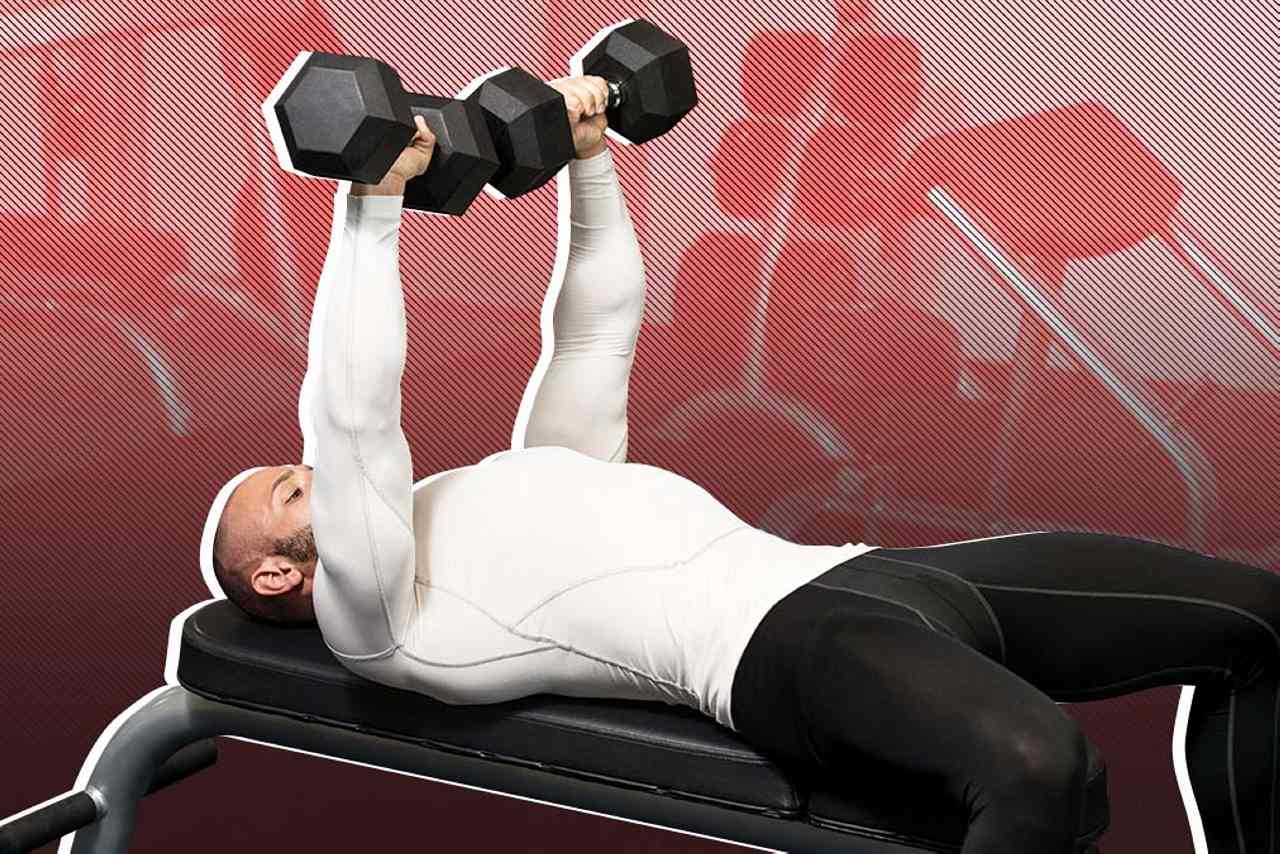A well-developed chest is a calling card of lifters who’ve spent months, if not years, dedicated to hard training. From lifters bench pressing jaw-dropping weight and bodybuilders hitting the classic “side chest” pose to beginners learning how to do a push-up, chest training has always been a high priority for anyone looking to build muscle or test their strength.
Whether you have limited equipment at home, access to a fully stocked commercial gym, or no equipment at all, you can find an effective chest workout to deliver the results you’re after. Take a look, choose your goal, and get training.
The Best Chest Workouts
- Best Chest Workout With Dumbbells
- Best Bodyweight Chest Workout
- Best Chest Workout for Muscle Mass
- Best Chest Workout for Strength
Best Chest Workout With Dumbbells
Not all lifters have the opportunity to train in a commercial gym and have turned to training in a home gym with whatever equipment they can put together. Training at home can have some incomparable benefits. It’s open 24 hours a day every day of the year, the music is never grating, and the dress code is more lenient than most public gyms to the point of being entirely optional if you’re into that sort of thing.
The biggest compromise with a home gym is typically a lack of options since equipment must be prioritized to accommodate limited floor space. Home lifters should outfit their training area with the basics, and often forgo multiple benches dedicated to specific angles, oversized cable machines with a selection of pulleys, and all sorts of standalone single-purpose machines for flyes or presses.
Fortunately, as long as you have a basic bench and an adjustable dumbbell set or a few pairs of dumbbells, you can always train your chest with the right plan. And here’s the plan to follow.
The Dumbbell-Only Workout
This workout focuses on exercise variety and techniques to increase time under tension to get the most benefit from limited equipment. Perform all sets of each exercise before moving to the next exercise, and perform the workout once or twice per week depending on your overall training split.
Single-Arm Flat Dumbbell Press
- How to Do it: Lie on a flat bench as if performing a standard dumbbell bench press, with a dumbbell in only one hand. The single-arm element makes this unilateral exercise an intense core drill while also recruiting the chest significantly.
- Sets and Reps: 3 x 6-8 per side
- Rest time: No rest between sides, 45 seconds rest between sets.
Neutral-Grip Incline Dumbbell Press
- How to Do it: Set the bench to an incline angle. If the bench cannot adjust, place blocks or weight plates under the feet to elevate one side several inches. Keep the hands facing each other, not facing your feet, to slightly decrease shoulder stress and increase pec recruitment.
- Sets and Reps: 4 x 10-12
- Rest time: 60 seconds between sets.
Flat Dumbbell Press With Pause
- How to Do it: Perform the classic flat dumbbell bench press, while pausing in the bottom (stretched) position of each rep for two seconds.
- Sets and Reps: 3 x 8-10
- Rest time: 60 seconds between sets.
Best Bodyweight Chest Workout
Sometimes having no equipment to train with can be a blessing in disguise. It forces you to be creative in program design, think outside the box, and buckle down to focus on only the most effective exercises.
Bodyweight training has a bad reputation for being “lesser than” training with free weights, but if you know what you’re doing and actually push yourself with the right movements, you’ll never call bodyweight training “easy” again.
The Brutally Simple Bodyweight Workout
When you think of “bodyweight chest exercise”, you think of push-ups. You might also think of dips, but technically you need dip bars for those, so they’re not truly a bodyweight-only exercise.
This workout could not be more straightforward. Do 100 push-ups, no matter how long it takes. Three to five days later, do 100 push-ups again but get them done in less time. It’s basic density training — get the same amount of work done in less time or do more work in the same amount of time.
Because 100 is a nice round number, that’s the stationary target and you’ll focus on shaving down the time each session. Also, it’s just kinda cool to be able to say, “I knocked out 100 push-ups this morning.” Knocking out 105 push-ups sounds strange.
The most critical element here is that, no matter how fatigued you are, you cannot sacrifice form to squeeze out ugly reps. It’s 100 perfect-technique push-ups, not 36 perfect push-ups followed by 64 half-reps. Each rep should have the chest nearly touching the floor (depending on your shoulder mobility) at the bottom and arms locked out at the top.
Push-up
- How to Do it: Support your body on your toes and hands, with your hands set slightly outside shoulder-width. While keeping a straight line from your neck to your ankles during each rep, bend your elbows to lower your entire body, and press to full lockout. To reduce shoulder joint strain, aim your elbows more towards your feet than your shoulders.
- Sets and Reps: 100 reps total, broken down into as many or as few sets as necessary until completion.
- Rest time: Rest as needed. Start a timer immediately before beginning the first rep and stop the timer immediately after completing the last rep. Record the total time and aim to improve by one second or more each workout.
Best Chest Workout for Muscle Mass
A muscle-building chest workout is a bodybuilder’s bread and butter. The typical lifter will reluctantly trudge through their leg day but channel that lack of enthusiasm into chest day, and that’s A-okay as long as they get their work done in each session.
Chest Day, Best Day
This is a time-tested, bodybuilding-style approach to training. Attacking a body part with multiple exercises and different angles, taking each set right up to muscular failure with high-intensity techniques, and ideally getting a serious pump in the target muscle by the end of the session.
This particular workout can standalone for a chest-only session or it can be followed by training the shoulders and triceps as part of a “pushing muscle” day. You can also get a complete upper body workout by training back immediately before chest or interspersing the exercises as supersets.
Dip
- How to Do it: Begin at the top position on a set of dip bars. Emphasize chest recruitment and stretch by leaning your upper body forward (not staying upright) as you bend your elbows and lower as far as mobility allows. Pause briefly before pressing back up.
- Sets and Reps: 3 x 8-12
- Rest time: 60 seconds between sets.
Pec-Deck With One-and-a-Half Reps
- How to Do it: On a pec-deck machine, set the seat so your hands are gripping the handles below shoulder height and in-line with your mid-chest. Perform each set using the “one and a half rep” technique by lowering the weight into a full stretch, raising the weight to full contraction, then lowering the weight halfway down, bringing it up to full contraction again, and finally lowering it fully. That’s counted as one full rep.
- Sets and Reps: 4 x 8-10
- Rest time: No rest before moving to the next exercise.
Flat Barbell Bench Press
- How to Do it: Take a beyond shoulder-width grip and lower the bar in-line with the mid-chest. If shoulder mobility allows, touch the bar to your chest briefly before pressing upwards. Be aware that the previous exercise will have pre-exhausted the chest muscles and they’re beginning this exercise already fatigued. Choose an appropriate weight and use a spotter if possible.
- Sets and Reps: 4 x 8-12
- Rest time: 90 seconds rest before returning to the previous exercise.
Smith Machine Incline Press
- How to Do it: Position a 30 or 45-degree incline bench under a Smith machine so the bar is lined up with your upper chest/collarbone area. Grip the bar slightly wider than the flat barbell bench press grip. Perform repetitions smoothly with no pause at lockout or in the stretch position, bringing the bar to at least chin-level at the bottom.
- Sets and Reps: 3 x 12-15
- Rest time: 45 seconds between sets.
Best Chest Workout For Strength
“How much ‘ya bench?” might as well be gym-speak for “Hi, how are you?” It’s asked as often and it’s answered as honestly. Everyone’s always “fine, thanks” and everyone always benches “around 300.”
Regardless of the questionable reputation as an ego lift, the bench press is a genuine assessment of upper body pressing power. Building a strong and powerful chest is, has, and will always be a priority for most dedicated lifters. Here’s a simple and effective plan to build serious pressing strength.
The Bigger Bench Plan
A chest-focused strength workout will, appropriately, be centered around the flat barbell bench press. It’s one of the classic “big three” powerlifts for a reason, because it’s one of the very few ways to move significant weight with an upper body press.
The once-a-week workout uses science-based explosive training, known as “post-activation potentiation”, to improve power output on the bench press, followed by specific accessory exercises to build strength in the chest and pressing muscles. (1)(2)(3)
Plyometric Push-up
- How to Do it: From a basic push-up position (hands and toes touching the ground, with a straight line from neck to ankles), descend under control to the bottom position and explode upwards with maximum force. The hands should leave the ground briefly. Catch yourself and pause at the top before performing the next rep.
- Sets and Reps: 5 x 5
- Rest time: 60 seconds before moving to the next exercise.
Flat Barbell Bench Press
- How to Do it: Take a beyond shoulder-width grip and lower the bar in-line with the mid-chest. If shoulder mobility allows, touch the bar to your chest briefly before pressing upwards. Pause at full lockout briefly before lowering the bar under control.
- Sets and Reps: 5 x 3
- Rest time: Three minutes before returning to the first exercise.
Floor Press
- How to Do it: Lie on the floor with a bar set in a rack at arms length above your head. Keep the legs straight throughout the set. Unrack the bar and lower under control until your elbows delicately touch the ground (do not slam the weight down). Pause with the elbows on the ground for one second before pressing to full lockout.
- Sets and Reps: 4 x 4-6
- Rest time: Three minutes between sets.
Dip
- How to Do it: Begin at the top position on a set of dip bars. Bend your elbows and lower to the bottom of the rep. The torso may be slightly upright during the movement to involve the chest, shoulders, and triceps. Pause briefly before pressing back up. Increase resistance with a weight belt, weighted vest, or by squeezing a dumbbell between your thighs above your knees.
- Sets and Reps: 4 x 6-8
- Rest time: Two minutes between sets.
The Chest Muscles
Many lifters design chest workouts with the intention of training “all parts of the chest”. That approach can certainly be effective, but it first requires knowing exactly what does, and what does not, make up “all parts of the chest.” Here’s a quick and useful lesson in functional anatomy.
Pectoralis Major
The pec major is the muscle everyone simply refers to as “the chest”. It’s the large chunk of muscle on the upper torso, above the abs and below the neck. Common bodybuilding lore says the body part is divided into the “upper chest”, “mid chest”, “lower chest”, “inner chest” and “outer chest”, while claiming each section can be targeted by specific exercises. This is wrong. Or at least, it’s a huge misinterpretation of how the body actually works.
The pec major is one muscle, just like the biceps are one muscle. However, just like the biceps include multiple heads which can be recruited differently to contribute to slightly different overall growth, the pec major contains two heads — the sternocostal and the clavicular.
The sternocostal head is responsible for the vast majority of movement and is recruited in all pressing exercises. The clavicular head is the region commonly referred to as “upper chest” and has been shown to be recruited more efficiently with exercises done at a 30 or 45-degree incline. (4) (5).
So, anatomically speaking, there’s “the upper chest” and “the rest of the chest”. The majority of exercises will work both heads, while inclined exercises prioritize the upper chest, and anyone who talks about targeting the “inner chest” or “outer-lower chest sweep” isn’t really talking about training the human body.
Pectoralis Minor
The pec minor lives underneath the pec major and attaches to the scapula (shoulder blade) to play a role in scapular movement. It’s involved in nearly every chest exercise, but is specifically called into action when the scapulae move forward, such as during a push-up or chest press exercise.
Due to its relatively small size, location, and function, it’s not likely to experience significant (or visible) muscle growth but serves an invaluable role for overall joint function and health.
Serratus Anterior
The serratus anterior is the finger-like cluster of muscles slightly below the chest, along the side of the ribs. Similar to the pec minor, they attach to the scapulae and play a role in scapular movement, stability, and health. (6) The serratus is also involved during chest pressing exercises, particularly toward the lockout position when/if the scapulae are allowed to “flex” forward (protraction).
Serratus muscle growth is minimal, but when the muscles are developed, and particularly when accompanied by low body fat, they can be a noticeable addition to an impressive physique.
A Chest Warm-Up is Essential
No matter your goal or training plan, a specific chest warm-up can help to improve overall performance and reduce the risk of injury. Pec tears, shoulder strains, and excessive elbow stress can occur when poorly planned workouts combine with inadequate warm-ups.
A thorough and effective warm-up can be time-efficient without compromising on benefits. Grab a resistance band and use this quick circuit to start any chest session.
The Complete Chest Warm-Up Circuit
- Slow Push-up Plus: Perform a basic push-up taking two seconds to lower your body and two seconds to press up. When your arms are locked at the top of each rep, continue “pressing” to reach the shoulder blades towards the ground before performing the next rep (this added range of motion is the “plus” part of a “push-up plus”). Do three repetitions before moving immediately to the next exercise.
- Push-up Plank Shoulder Tap: From the top of a push-up position, spread your feet slightly wider for support and alternate touching each shoulder with the opposite hand. Perform 10 reps total, alternating each hand, before moving immediately to the next exercise.
- Band Pull-Apart: Take a resistance band with a palms-down grip, holding the band at arms-length in front of your body. Keeping a slight bend in your elbows, pull both hands back to perform a reverse flye movement with your shoulders and upper back until the band touches your chest. Return to the starting position under control. Perform 10 reps before repeating the first exercise. Do a total of four sets of the complete circuit.
Plank w/shoulder taps
Watch this video on YouTube
Powerful, High-Performance Pecs
Whether you want to bench press a motorcycle, build a beach-worthy physique, or just get a great workout at home or on the road, you’re now armed with plenty of options to train what is arguably the most popular body part in the gym. Just be sure to follow a well-designed plan and never let your ego write checks your joints can’t cash.
References
- Krzysztofik, M., & Wilk, M. (2020). The Effects of Plyometric Conditioning on Post-Activation Bench Press Performance. Journal of human kinetics, 74, 99–108.
- https://doi.org/10.2478/hukin-2020-0017Ulrich G, Parstorfer M. Effects of Plyometric Versus Concentric and Eccentric Conditioning Contractions on Upper-Body Postactivation Potentiation. Int J Sports Physiol Perform. 2017 Jul;12(6):736-741. doi: 10.1123/ijspp.2016-0278. Epub 2016 Oct 13. PMID: 27736266.
- Clark, Ross A1,3; Humphries, Brendan2; Hohmann, Erik3,4; Bryant, Adam L1 The Influence of Variable Range of Motion Training on Neuromuscular Performance and Control of External Loads, Journal of Strength and Conditioning Research: March 2011 – Volume 25 – Issue 3 – p 704-711 doi: 10.1519/JSC.0b013e3181c6a0ff
- Lauver JD, Cayot TE, Scheuermann BW. Influence of bench angle on upper extremity muscular activation during bench press exercise. Eur J Sport Sci. 2016;16(3):309-16. doi: 10.1080/17461391.2015.1022605. Epub 2015 Mar 23. PMID: 25799093.
- Rodríguez-Ridao, D., Antequera-Vique, J. A., Martín-Fuentes, I., & Muyor, J. M. (2020). Effect of Five Bench Inclinations on the Electromyographic Activity of the Pectoralis Major, Anterior Deltoid, and Triceps Brachii during the Bench Press Exercise. International journal of environmental research and public health, 17(19), 7339. https://doi.org/10.3390/ijerph17197339
- Castelein B, Cagnie B, Parlevliet T, Cools A. Serratus anterior or pectoralis minor: Which muscle has the upper hand during protraction exercises? Man Ther. 2016 Apr;22:158-64. doi: 10.1016/j.math.2015.12.002. Epub 2015 Dec 22. PMID: 26749459.
Feature Image: Jasminko Ibrakovic / Shutterstock
About Chris Colucci
Chris has spent more than 20 years studying health and fitness beginning at a supplement store in the local shopping mall, earning a brown belt in Kenpo Jiujitsu and teaching martial arts to kids and adults, personal training with clients including competitive athletes and 80-year olds, interviewing legends of the strength world, and fine-tuning countless articles from expert coaches. In his “spare” time, he studies late-19th and early-20th century physical culture; takes care of his wife, kids, dogs, and cats; and tries to keep his vegetable garden producing year-round.













